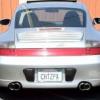Lewis, I've continued to follow your journey with interest -- you have my sympathies in this frustrating, long-running matter. At the risk of jinxing myself, I wanted to provide an update regarding some of my own recent experiences that may provide some additional areas for exploration. Somewhat like you, I had a stuttering in power that was particularly noticeable (to me) in the middle RPMs under medium to full throttle, but also faintly there even under light throttle on my 06 CTT. One day last year, I started having hot start issues after refueling, which is generally indicative of purge valve issues. So after a few months of this annoyance [having to floor the accelerator to get the engine started after refueling], I decided to check out the purge valve to see what it was actually doing. I found that the purge valve is normally closed, thus keeping the tank vapors from being ingested. In my case, I could apply power to the purge valve with jumper leads, and it would click, suggesting that it was working. Except that as I continued to cycle the valve, it would eventually [heat up and] get stuck open (as confirmed by sucking through it - - yuck). A stuck open purge valve would appear to act either as a vacuum leak and/or extra source of fuel - - but you'd never find it on a smoke test, because there is a check valve in front of the purge valve that keeps intake boost from pressurizing the fuel tank vent system, so you won't see it as a leak by normal means. But when it's open, the purge valve admits unmetered air/fuel to the engine. I think the ECM, in conjunction with good O2s, is probably capable of dealing with this extra air/fuel, at least under steady conditions like idle or cruise or whenever the purge valve would ordinarily be commanded to be open. But one could envision how slow O2s and/or a bad purge valve leak would cause the ECU to hunt for the right A/F mix, particularly under dynamic situations, resulting in rough running or stuttering. So in my case, I did an experiment - - mostly because I was sick of the hard start after fueling up. I put a vinyl/rubber vacuum cap over the intake side of the purge valve nipple, the part that the rubber hose slides over. I used a pick to poke a small hole in this cap (~1mm or less) and reassembled the intake hose over the cap onto the purge valve nipple. Result: 1) No more hard starts after refueling 2) No check engine lights (I was worried about not enough vacuum being pulled on the tank and triggering an emissions issue) 3) STUTTERING UNDER ACCELERATION WAS GONE! It runs great and strong! Transmission shifts better/smoother too. Its all linked on these cars. 4) I occasionally get a faint gasoline smell in the cabin, but I think it was actually worse before my hack/test. I suspect I need new fuel filter/pump/tank gaskets. I think this is unrelated, but I wanted to mention it, because I may not be pulling as much vacuum on the tank as the factory designed given that I've restricted the purge valve. I've driven like this now for about 3-4 months and it seems great. I bought a new replacement purge valve, but haven't gotten around to installing it. I don't know if this hack will fix your car - - it may not given that you've reportedly already replaced your purge valve, although I suppose its possible that the replacement has also failed - - but I do think it's a simple test/fix for anyone with possible purge valve issues. A few additional thoughts: 1) The simplest way to test this purge valve theory would be to disconnect the rubber hose from the purge valve and completely plug/cap the rubber intake hose (not the PV) with something. While this may throw a code over time, it would be a quick test of whether the purge valve is the source of your surging. 2) For those looking at this as a permanent fix, I used a small vinyl vacuum cap with small hole in it to restrict the flow. I figured that it would be held in place by the hose/clamp that went around it. It worked, but note that the cap got stuck in the rubber intake hose when I pulled the hose off after a test fit. No biggie, but I needed to thread a screw through the hole in the cap so I could fish it back out of the hose to reinstall it on the purge valve upon reassembly. Hope that makes sense. 3) There are likely other ways of restricting the rubber hose to the purge valve - - whatever you pick, make sure it won't damage your engine if it gets sucked in accidentally. Soft materials like rubber or vinyl are probably best. 4) I didn't experiment with the size of the orifice, but I'd think there's probably a sweet spot. The hole I made with the pick was pretty small, but definitely flowed air/vacuum. Start small. If you get a check engine light, consider enlarging the hole a bit more. Lastly, and unrelated to the above fix, have you replaced the primary O2s? It made a world of difference on my 997, even though the sensors had less than 50k miles on them. Much improved running under all conditions. My guess is that the O2s get slower to respond over time, making any real-time A/F issues much more noticeable. Hope that helps, and best wishes. Sent from my Nexus 6 using Tapatalk

-0001-0001.thumb.png.17f5bb25bf8ec261a17c21e6321c8492.png)
